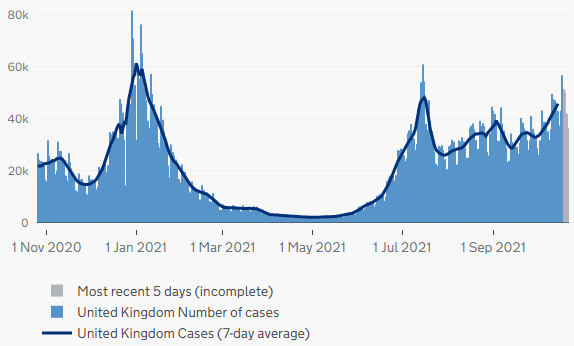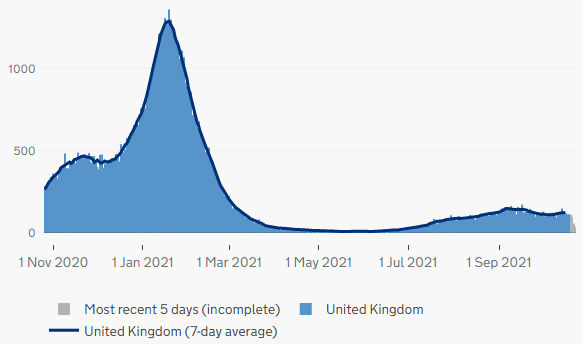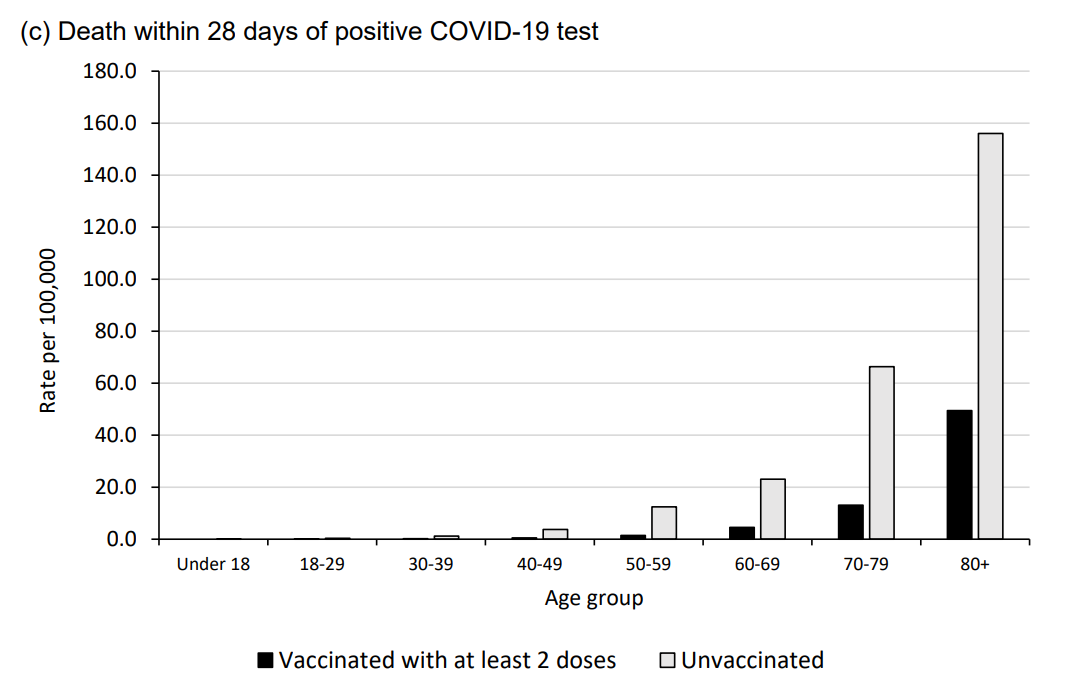

RECLAMACION: “the vaccinated population accounted for 72% of Covid-19 hospitalisations”; “the vaccinated population accounted for 83% of Covid-19 deaths [in Scotland]”; “In the U.K., more than 70% of the people who die now from COVID are fully vaccinated.”
REVIEW
Almost 80% of people aged 12 and over in the U.K. have been fully vaccinated against COVID-19. The level of protection provided by the vaccines means that the number of COVID-19 deaths is about 10% of the level seen in the previous wave (120 deaths per day compared to 1,200), despite the number of cases being at a similar level (Figure 1).


Figure 1. Graphs taken from the U.K. COVID-19 dashboard showing the number of cases (left) and deaths (right). The line represents the rolling 7-day average between 26 October 2020 and 25 October 2021.
The COVID-19 vaccines are highly effective against symptomatic disease, hospitalization, and death, however they don’t provide complete protection. Estimates from August 2021 by a vaccine effectiveness expert panel advising the U.K. Government suggest that the Pfizer-BioNTech and Oxford-AstraZeneca COVID-19 vaccines are 95% effective at preventing hospitalization and death from the COVID-19 Delta variant, which is the most common variant circulating in the U.K.
Proportions of hospitalization and death are lower among vaccinated
An article on The Exposé, a website labeled as promoting conspiracy theories by Media Bias/Fact Check, used figures published by Public Health Scotland to claim that “the vaccinated population accounted for 72% of Covid-19 hospitalizations between September 18th and October 15th 2021, whilst the not-vaccinated accounted for just 28%.”
As explained in a previous Health Feedback review, these figures are missing important context, most notably the difference in the number of vaccinated people compared to those who are unvaccinated.
The Public Health Scotland report states that 92% of adults aged 18 and over in Scotland have had at least one dose of the COVID-19 vaccine. This figure is even higher, approximately 100%, among the elderly, who were prioritized for vaccination due to their higher risk of severe COVID-19. Since vaccinated people far outnumber unvaccinated people, directly comparing the number of deaths in one group to the other, as the Exposé article did, does not tell us anything about the vaccines’ effectiveness. In order to determine whether the vaccines are effective at reducing the risk of death, we need to instead compare the proportion of hospital admissions between the vaccinated and unvaccinated groups.
The data from Public Health Scotland showed that the risk of hospitalization is approximately twice as high for someone of a similar age who hasn’t been vaccinated. There are many other factors that would need to be taken into account to produce a scientifically robust comparison of the two groups, however this demonstrates that comparing the number of admissions gives a misleading picture.
In June and July 2021, the majority of COVID-19 positive cases that were hospitalized in Scotland were unvaccinated. This proportion decreased over time as more people were fully vaccinated.
In addition, there were changes in the age profile of the people catching COVID-19. The summer saw a rise in COVID-19 cases circulating in Scotland due to the Delta variant, relaxing of restrictions, and the European football championship, particularly among young men. Over time, the rise in cases among the young began to affect the elderly, who are most at risk of hospitalization. On 27 June 2021, only 2.3% of cases were among people aged 65 and over, but by 3 October 2021 this had increased to 10.9%. Even with 95% vaccine effectiveness against hospitalization, we would expect to see a significant increase in COVID-19-related admissions in this vulnerable age group.
The figures from Scotland are based on people who were admitted to hospital with a positive COVID-19 test within the previous 14 days, on admission, or during their hospital stay. This could lead to cases being detected either by routine testing on admission in people who are asymptomatic, or by patients contracting COVID-19 while staying in hospital. This means that the figures could be skewed by the elderly, who are more likely to be vaccinated and more likely to be admitted to hospital for non-COVID-19-related reasons.
The Public Health Scotland report said:
“Please note that these statistics do not differentiate between individuals in hospital with COVID-19 illness requiring hospitalisation compared to those in hospital for other reasons (e.g. routine operations) for whom COVID-19 was identified incidentally through testing but they are not requiring hospitalisation because of their COVID-19 symptoms.”
With this uncertainty about whether the hospitalizations are due to COVID-19 or not, it is difficult to draw conclusions based on this data. However, the fact that the vaccinated people have half the risk of testing positive in hospital suggests that the vaccine provides protection from contracting COVID-19, from severe disease requiring hospital treatment, or both.
The Exposé article also claimed that 83% of COVID-19 deaths were among the vaccinated population. This also misses the important context that the vast majority of the adult population are vaccinated, and the vaccination rate is higher among the elderly and most vulnerable. Since older people are more likely to die from COVID-19, researchers need to account for the differences in the number of vaccinated and unvaccinated people and the differences in age when calculating mortality rate.
This is what Public Health Scotland did with their calculation of the age-standardized mortality rate for the two groups. Based on these calculations, they found that the mortality rate, when controlled for differences associated with age, is approximately three times higher for unvaccinated people compared to those who were vaccinated. Again, if anything, this demonstrates that the vaccines are protective and that comparing the raw numbers of deaths is misleading.
These deaths were defined as an individual who has tested positive by PCR for SARS-CoV-2 at any time point and has COVID-19 listed as an underlying or contributory cause of death on the death certificate.
The report says that the data:
“does not assess the effectiveness of the vaccine or whether the vaccine has worked in these individuals. The latter requires a careful examination of each case to explore possible reasons, which could be related to the test, virus or the person (e.g. pre-existing conditions).”
Studies of the effectiveness of the COVID-19 vaccines need to take into account further differences between the vaccinated and unvaccinated populations and the circumstances of these deaths. A simple comparison of the number of deaths doesn’t provide useful information for assessing the benefits of vaccination.
Older people are more at risk of dying
A similar claim was made on the Joe Rogan Experience podcast, where Alex Berenson, a former New York Times journalist who was recently banned from Twitter for spreading misinformation on COVID-19, claimed that “In the U.K., more than 70% of the people who die now from COVID are fully vaccinated”. These claims have since been repeated elsewhere.
This was based on figures published by Public Health England (now the U.K. Health Security Agency) in a report on 23 September 2021, covering the period from 23 August to 19 September 2021. These deaths in England are based on a person having tested positive for COVID-19 within the previous 28 days.
As with the claims in The Exposé, while the figure is correct, it is missing the important context of the high vaccine coverage in the population. Again, rather than looking at the raw numbers, we would need to compare the likelihood of deaths in the two groups.
In the same report, Public Health England published a chart showing the difference in death rates between vaccinated and unvaccinated people by age group. This shows that there is a significantly higher likelihood of COVID-19-related deaths in unvaccinated people. Without this information, Berenson’s claim misleads people about the conclusions of the report.
 Figure 2. Graph taken from the Public Health England COVID-19 vaccine surveillance report (week 38), showing the rate of deaths by age and vaccination status.
Figure 2. Graph taken from the Public Health England COVID-19 vaccine surveillance report (week 38), showing the rate of deaths by age and vaccination status.
As the graph shows, unvaccinated people are three to five times more likely to be among COVID-19 deaths.
People aged 80 and over account for over half the COVID-19-related deaths, according to the report, which also showed that about 95% of this age group are vaccinated. So it is not surprising that the vaccinated population would account for most deaths, given that this includes the vast majority of the adults, especially the most vulnerable.


